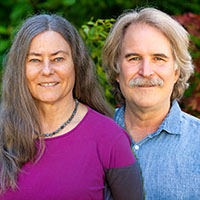Farm Like Our Health Depends On it
 In this episode of Unconfined, the formidable husband-and-wife team of David Montgomery and Anne Biklé draw on their deep experience as environmental scientists, gardeners, and celebrated book authors to show that regenerative farming isn't some crunchy fad or marketing jargon to be seized by giant meatpacking and pesticide firms. Rather, it might hold the key to keeping our farms humming as the climate warms and addressing our epidemic of diet-related health troubles.
In this episode of Unconfined, the formidable husband-and-wife team of David Montgomery and Anne Biklé draw on their deep experience as environmental scientists, gardeners, and celebrated book authors to show that regenerative farming isn't some crunchy fad or marketing jargon to be seized by giant meatpacking and pesticide firms. Rather, it might hold the key to keeping our farms humming as the climate warms and addressing our epidemic of diet-related health troubles.

Regenerative Agriculture’s Dynamic Duo Dig into the Connections Between Soil and Public Health
By Tom Philpott Subscribe to Host Notes
The companies that prop up industrial-scale meat production have an important message for you. "Produce More. Restore Nature. Scale Regenerative Agriculture," reads the website of seed/pesticide behemoth Bayer. "It's essential to consider the tangible results of regenerative agriculture," enthuses an executive at rival Corteva on LinkedIn. "Our vision is to make regenerative agriculture commonplace across our global supply chains – helping farmers produce food more sustainably while increasing their profitability and resiliency," the meatpacking and grain-trading giant Cargill recently insists.
While these titans of US agriculture rhetorically embrace what they call regenerative farming, a funny thing is happening in the Corn Belt, the region where they exert the most influence. It's where their seeds and pesticides fuel bumper corn and soybean harvests that suffuse our food system, and where factory-like barns and feedlots transform that bounty into the cheap pork, beef, and eggs that underpin our diet. There, soil is vanishing on a grand scale, and streams, aquifers, rivers, and lakes serve as catchment zones for toxic agrichemical runoff.
In 2021, a team of University of Massachusetts Amherst scientists, led by geomorphologist Isaac Larsen, began publishing a series of papers examining the scale of soil erosion in the Corn Belt—a broad swath of land stretching from Nebraska to Ohio and as far south as Missouri. Their first paper found that in fully one-third of the region, the layer of loamy, fertile soil has already washed away since U.S. farmer-settlers seized the area in the 19th century and subjected it to the plow. Another one found that what's left is currently being lost at a pace as much as 1,000 times the natural pace of replenishment.
When soil goes on the move, so do the agrichemicals that get applied to it year after year. It's no wonder that nitrates from fertilizer and livestock manure—a likely carcinogen even at low levels—routinely pollutes drinking-water supplies throughout the region; or that a plague of harmful algae blooms appear annually from Lake Erie clear to the Gulf of Mexico, where most of the runoff ends up.
If the agribusiness vision for regenerative agriculture delivers recurring ecological crises, what does actual regenerative farming look like—the kind that holds soil in place while also enriching it with carbon pulled from the atmosphere? That's the topic of Unconfined podcast's current series of three episodes. For the newest one, I interviewed the husband-and-wife team of David Montgomery and Anne Biklé, who have emerged as perhaps our most important public intellectuals on the topic.
Montgomery, a geomorphologist in the University of Washington's Department of the Environment, is the author of the 2007 book Dirt: The Erosion of Civilizations, where he showed in scathing detail that “with just a couple feet of soil standing between prosperity and desolation, civilizations that plow through their soil vanish.” (He was the graduate advisor to Isaac Larsen, the U Mass scientist now documenting erosion in the US Corn Belt.)
Since the publication of Dirt, Montgomery has published two important books with Biklé, a renowned biologist, displaying an enviable ability to make dry scientific findings spring to life on the page. In The Hidden Half of Nature (2016), they sweat the small stuff: the trillions of bacteria and fungi that live in our guts and in a teaspoon of quality soil. Montgomery and Biklé show that the health and biodiversity of these distinct microbiomes are crucial to human health—and how they're both under attack from industrial agriculture. Crucially, they also show that through careful eating and better farming (not the kind that's profitable for Bayer and its peers), both can be restored.
Their recent book, What Your Food Ate, dives into the deep connection between human and soil health, arguing convincingly that a diet of whole foods from plants and animals raised on regeneratively farmed land can help prevent many of the diet-related maladies that inflict Americans on an epidemic scale.
In conversation, Montgomery and Biklé are as engaging and precise as they are in prose. I got them to tease out the scientific case for regenerative agriculture—and present a vision for it that directly indicts our agricultural status quo. Tune in!
In Host Notes, the voices behind Unconfined podcast deliver additional context to supplement our interviews. Their views do not necessarily reflect those of the Johns Hopkins Center for a Livable Future or the Johns Hopkins University.